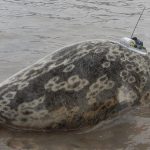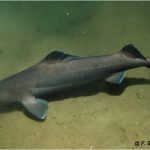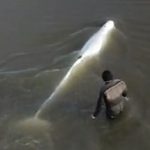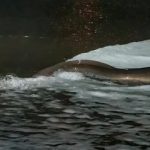← Back
Harbour porpoises in the Wadden Sea
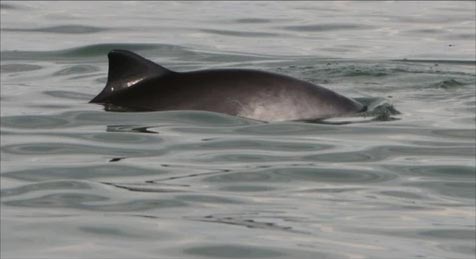
Some marine areas, such as the Wadden Sea, along the North Sea coasts of Denmark, Germany and the Netherlands, are of special interest. Among the species found there, the harbour porpoises are considered as essential components of the ecosystem. Argos helps in understanding their behaviour and habitat, which enables proposing joint conservation measures to the three countries.
The Wadden Sea is a United Nations Sea World Heritage Site, thus designated for the presence of Outstanding Universal Values. It lies along the North Sea coasts of three different countries (Denmark, Germany and the Netherlands), which have been cooperating since 1978 in joint conservation efforts.
The harbour porpoise (Phocoena phocoena) is among the marine mammal species considered as essential components of the Wadden Sea ecosystem: harbour seal (see Assessing exposure of harbour seals to maritime traffic noises), grey seal and harbour porpoise. However, there is currently no joint framework for coordinated monitoring of harbour porpoises in the Wadden Sea.
The objectives for the conservation of the harbour porpoises within the Wadden Sea World Heritage Site are to maintain a stock with the capacity to reproduce naturally and to conserve their habitat quality. To assess the current situation and the measures to take, a study was led collating and analysing a large range of data (telemetry, aerial surveys, strandings and passive acoustic monitoring, over the years 1990–2020) collected by research institutes from Denmark, Germany and the Netherlands.
Results from tracked harbour porpoises
On the telemetry aspect of the study, the Argos tracks from six porpoises caught and tagged in the Wadden Sea were used. These tracked porpoises are part of a database of 124 porpoises tagged in the Danish waters by Aarhus University (AU) since 1997.
Tagging enables to get long-term information on individuals’ behaviours, on small and large scale alike, and, ultimately, to model the species’ seasonal movements and preferred habitats. Six male harbour porpoises (five juveniles, one adult) were tagged within the boundaries of the Wadden Sea.
More info about animal tracking with Argos
![Left, map of the locations within (red lines) or just outside the Wadden Sea from the tracked harbour porpoises, both tagged within the Wadden Sea (green dots), and at other places (black dots). Right, the locations of the individuals tagged within the Wadden Sea. Yellow stars indicate the two locations where the animals were tagged (from [Scheidat et al., 2024])](https://www.argos-system.org/wp-content/uploads/2024/05/12526_2024_1428_Fig13_HTML-1024x586.png)
Only one animal ventured about 70 km into the North Sea during the winter months. Two-third of the locations (average per individual) were within the Danish or German part of the Wadden Sea, mostly in shallow waters (coastal and intertidal waters, less than 10-m deep) with seasonal movements and changes in local occurrence over time.
Some areas were often visited, and some of the porpoises’ home ranges throughout the year were limited, although the tracking showed individual variability in both space and time, but also depended on the age.
This was the first time porpoises were tagged in the Wadden Sea and the behaviour of the six porpoises were distinctly different from the porpoises tagged in other areas, suggesting that they may belong to a special group of animals that are adapted to the unique environment of the Wadden Sea.
![Locations coloured by season (spring: March to May, summer: June to August, fall: September to November, winter: December to February) for the six harbour porpoises tagged within the Wadden Sea. Yellow stars indicate the locations where the animals were tagged. (from [Scheidat et al., 2024])](https://www.argos-system.org/wp-content/uploads/2024/05/12526_2024_1428_Fig14_HTML-1024x726.png)
Other techniques
The Small Cetacean Abundance in the entire North Sea (SCANS) surveys estimated the population size to be similar in 1994, 2005, 2016 and 2022.
However, a large-scale southward shift in distribution within the North Sea has been documented, which is supported by stranding data for the Wadden Sea area with an increase of stranding records along the Dutch coastline since 2000 with a peak during 2008–2014.
The stranding data show seasonal patterns, with most animals stranding during the summer in the northernmost part of the Wadden Sea. Aerial surveys conducted in German waters confirm this summer peak.
Acoustic monitoring showed that porpoises use both the inner and outer waters of the Wadden Sea on a regular basis throughout the year.
Conservation recommendations
The Wadden Sea Plan concerning harbour porpoises aims to maintain a viable stock, and also to conserve a good habitat quality for the species. To asses that this goal has been reached, a coherent monitoring should be developed in the frame of a management scheme involving the three countries.
Reference & links
Scheidat, M., Vrooman, J., Teilmann, J. et al. Harbour porpoise (Phocoena phocoena) in the Wadden Sea World Heritage Site and requirements for trilateral monitoring. Mar. Biodivers. 54, 42 (2024). https://doi.org/10.1007/s12526-024-01428-6

